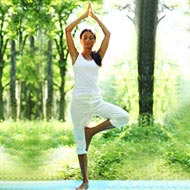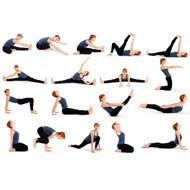- Ashtanga & Power Yoga
- Bikram Yoga
- Iyengar Yoga
- Kundalini Yoga
- Vinyasa Yoga
- Hatha Yoga
- Jivamukti Yoga
- Karma Yoga
- Dahn Yoga
- Mantra Yoga
- Nada Yoga
- Patanjali Yoga
- Viniyoga
- Svaroopa Yoga
- Kali Ray Triyoga
- Ishta Yoga
- Integral Yoga
- Zen Yoga
- Kripalu Yoga
- Shakti Yoga
- Kriya Yoga
- Om Yoga
- Sivananda Yoga
- Ashtanga Yoga
- What is Karma?
- Power Yoga
Types Of Yoga
Today many different styles of yoga are being taught and practiced throughout the world. Even though all of them are based on the same physical poses (called asanas), each style has a distinct accent. Given below is a nippy guide to the most popular Yoga styles.
It will help you figure out your needs and, accordingly, decide which one is right for you.
Ashtanga & Power Yoga In Sanskrit, Ashtanga means 8 limbs.
This is a fast-paced, intense Yoga style, in which a set series of poses is performed, always in the same order. Ashtanga is also the inspiration for what is often referred to as Power Yoga. If a class is described as Ashtanga Yoga, it is sure be a flowing style.
Bikram Yoga is founded by Bikram Choudhury. His style consists of a set series of 26 poses and is also called Hot Yoga, since it is practiced in a 95-100 degree room. This facilitates relaxing of tight muscles together with copious amounts of sweating, thought to be cleansing.
Hatha Yoga is a very general term for all forms of physical Yoga. Typically, a Hatha Yoga class is slow-paced and gentle.
It is said to provide a good introduction to the basic yoga asanas.
Iyengar Yoga is based on the teachings of Yogacharya B.K.S Iyengar. His style is more concerned with bodily alignment. Iyengar Yoga normally emphasizes staying in an asana for long periods as against proceeding rapidly from one to another.
In Kundalini Yoga more stress is laid on the Pranayama (breathing techniques) together with physical movement. The intention is to free the energy in one's lower body and let it to proceed upwards. Kundalini also employs quick, recurring movements rather than staying in one pose for long.
Vinyasa Yoga means breath-synchronized movement and is a more dynamic style based on the performance of a series of asanas in which movement is synchronized with to breathing.
What do you mean by vinayasa yoga?
Vinyasa Yoga can be descried as a particular discipline, which mainly focuses on a flow of certain movements that are performed between each pose within that series. As the practitioner of Vinyasa Yoga poses flows from one pose to the next in a fluid motion, this discipline is also referred to as Flow Yoga. One of the most important aspects of this style is the right breathing technique. This flow can also be incorporated into other yoga forms, like Bikram Yoga. This style of yoga is very popular with younger people and fitness enthusiasts, who would like to enjoy the various benefits of yoga, without engaging in its classical or traditional form. Besides this, power yoga and hatha yoga are also other forms that are practiced by many.
How hatha yoga helps to improve balance?
Hatha yoga is normally practiced by beginners as it is mild and easy to perform. Some of the hatha yoga advantages on the mind and body are mentioned below.
- Correcting posture and strengthening the spine
- Decreasing the levels of cholesterol and sugar in the body
- Easing back pain and aches in the muscles and joints
- Encouraging weight loss
- Improving flexibility and mobility in the joints
- Increasing circulation, which improves the health of the heart
- Promoting focus and concentration
- Strengthening, building and toning up the muscles
It is important to get a yoga teacher to guide you through the session so as to minimize the hatha yoga side effects.
What Is Dahn Yoga ?
Dahn Yoga, also referred to as Dahn Hak or Dahnhak, is a Korean system of yoga. Since Dahn stands for "vital energy" and Hak is "the study of a specific theory", the definition of dahn yoga is "the study of primal, vital energy". It is said that Dahn Hak places equal emphasis on a person's emotional, spiritual and physical wellbeing. Modern practitioners of yoga define Dahn Yoga as "A practice that blends Yoga with Tai Chi and other martial arts."
The history of Dhan Yoga states that it was started in 1985 by a Korean, Ilchi Lee. The first Dahn Yoga Center in the US was opened in the year 1991, in Philadelphia.
Despite the controversies that claim dhan yoga is a cult, there are several people claim to have benefited immensely from this practice.
Does Ashtanga And Power Yoga Are One? Or They Are Different?
Of the different yoga styles one of the most popular styles of yoga in the West is Power Yoga, which is ideal for those who are young and fit, as it is a quite strenuous. However, many beginners wonder if there is any difference between ashtanga and power yoga styles.
While Power yoga is modeled quite closely to Ashtanga yoga, it is important to realize that there are many differences between ashtanga and power yoga practice. Power yoga has no set pattern and one class can be completely different from another, depending on the person conducting it. On the other hand, Ashtanga yoga is structured and has a set pattern of poses. This style is ideal for those who would prefer to practice yoga at home.
Before practicing any ashtanga and power yoga poses, it is important to consult a doctor and get an approval.
What Is Iyengar Yoga ?
Iyengar yoga can be described as a form of yoga that is known for its focus on the proper alignment of the body. This increases stability, improves circulation throughout the body, creates inner space and balances the flow of energy in the body.
An iyengar yoga poses could comprise of various sitting or standing asanas or poses. Some of these poses include:
• Tadasana (The Mountain Pose)
• Trikonasana (The Triangle Pose)
• Parsvakonasana (The Extended Side Angle Pose)
• Parivritta Parsvakonasana (The Revolved Side Angle Pose)
• Virabhadrasana I, II & III (The Warrior Pose I, II & III)
• Padangusthasana (The Hand To Big Toe Pose)
• Uttanasana (The Standing Forward Bend Pose)
• Paschimottasana (The Seated Forward Bend Pose)
• Adho Mukha Svasana (The Downward Facing Dog Pose)
• Sarvangasana (The Shoulder Stand)
It is necessity to have a yoga professional help you with the poses if you are a beginner.



